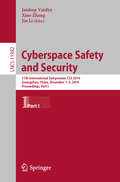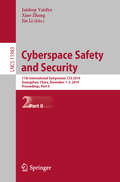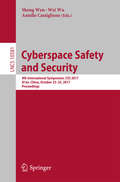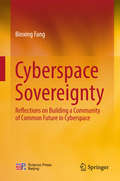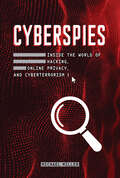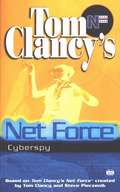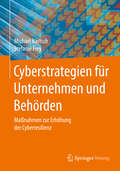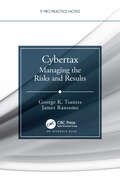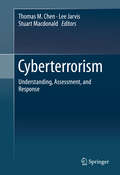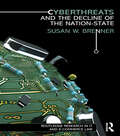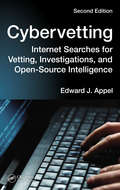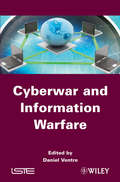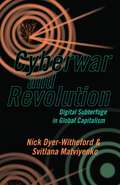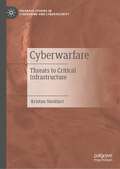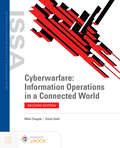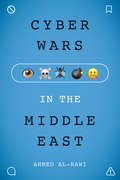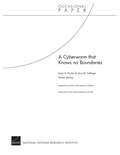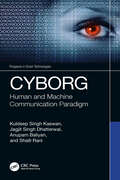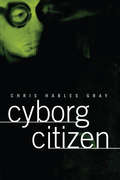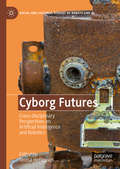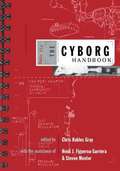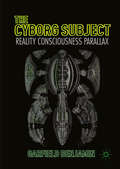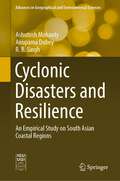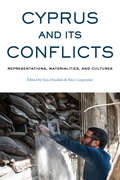- Table View
- List View
Cyberspace Safety and Security: 11th International Symposium, CSS 2019, Guangzhou, China, December 1–3, 2019, Proceedings, Part I (Lecture Notes in Computer Science #11982)
by Jin Li Jaideep Vaidya Xiao ZhangThe two volumes LNCS 11982 and 11983 constitute the proceedings of the 11th International Symposium on Cyberspace Safety and Security, CSS 2019, held in Guangzhou, China, in December 2019.The 61 full papers and 40 short papers presented were carefully reviewed and selected from 235 submissions. The papers cover a broad range of topics in the field of cyberspace safety and security, such as authentication, access control, availability, integrity, privacy, confidentiality, dependability and sustainability issues of cyberspace. They are organized in the following topical sections: network security; system security; information security; privacy preservation; machine learning and security; cyberspace safety; big data and security; and cloud and security;
Cyberspace Safety and Security: 11th International Symposium, CSS 2019, Guangzhou, China, December 1–3, 2019, Proceedings, Part II (Lecture Notes in Computer Science #11983)
by Jaideep Vaidya Xiao Zhang Jin LiThe two volumes LNCS 11982 and 11983 constitute the proceedings of the 11th International Symposium on Cyberspace Safety and Security, CSS 2019, held in Guangzhou, China, in December 2019.The 61 full papers and 40 short papers presented were carefully reviewed and selected from 235 submissions. The papers cover a broad range of topics in the field of cyberspace safety and security, such as authentication, access control, availability, integrity, privacy, confidentiality, dependability and sustainability issues of cyberspace. They are organized in the following topical sections: network security; system security; information security; privacy preservation; machine learning and security; cyberspace safety; big data and security; and cloud and security;
Cyberspace Safety and Security: 9th International Symposium, CSS 2017, Xi’an China, October 23–25, 2017, Proceedings (Lecture Notes in Computer Science #10581)
by Wei Wu Aniello Castiglione Sheng WenThis book constitutes the proceedings of the 9th International Symposium on Cyberspace Safety and Security, CSS 2017, held in Xi'an, China in October 2017. The 31 full papers and 10 short papers presented in this volume were carefully reviewed and selected from 120 submissions. The papers focus on cyberspace safety and security such as authentication, access control, availability, integrity, privacy, confidentiality, dependability and sustainability issues of cyberspace.
Cyberspace Sovereignty: Reflections On Building A Community Of Common Future In Cyberspace
by Binxing FangThis book is the first one that comprehensively discusses cyberspace sovereignty in China, reflecting China’s clear attitude in the global Internet governance: respecting every nation’s right to independently choose a development path, cyber management modes and Internet public policies and to participate in the international cyberspace governance on an equal footing. At present, the concept of cyberspace sovereignty is still very strange to many people, so it needs to be thoroughly analyzed. This book will not only help scientific and technical workers in the field of cyberspace security, law researchers and the public understand the development of cyberspace sovereignty at home and abroad, but also serve as reference basis for the relevant decision-making and management departments in their work.
Cyberspies: Inside the World of Hacking, Online Privacy, and Cyberterrorism
by Michael MillerThe news is filled with stories of data breaches at companies and of threats to national security as hackers interfere with elections. It's more important than ever for internet users to know how to maintain their privacy online. The digital world has become inescapable, and to be a responsible digital citizen, it is necessary to be aware of the threats to your online privacy and security. This book looks at the legal and illegal forms of cyberspying, goes behind the scenes to explore career paths in cyberintelligence, and looks at the digital threats of cyber propaganda, fake news, cyberterrorism, and threats to the US government and individuals. Readers will learn tools to keep themselves safe and protect their privacy, as well as tips for what to do if they are attacked online, and a final chapter looks at how digitally savvy teens can prepare for a career in cyberintelligence.
Cyberspy (Tom Clancy's Net Force Explorers #6)
by Steve Pieczenik Bill Mccay Tom ClancyThe inside secrets of big business are being leaked onto the Net. But the culprit is not just a kid hacker showing off. It's a cadre of spies who are using a revolutionary, new "wearable" computer to tune in to people's thoughts. And Net Force Explorer David Gray must try to keep the people he works with -- and his friends -- from being fatally crushed by the unknown spies...
Cyberstrategien für Unternehmen und Behörden
by Michael Bartsch Stefanie FreyDie Autoren beschreiben in diesem Buch, wie eine Cybersicherheitsstrategie entwickelt und umgesetzt wird. Dabei beleuchten sie die geopolitischen Einflüsse wie auch die organisatorischen und technischen Rahmenbedingungen. Cyberrisiken entstehen durch den Einsatz von Informationstechnologien, beinhalten aber auch organisatorische und technische Risiken und sind somit nicht nur ein Problem der IT-Abteilung, sondern der Unternehmensleitung. Eine Cyberstrategie sollte daher ein Teil der Unternehmensstrategie sein und nicht nur ein Teil der IT-Strategie.Die staatliche und die unternehmerische Sicherheitsvorsorge werden bei der Cyberproblematik immer enger zusammenarbeiten müssen. Nur so können Wirtschafträume im Cyberspace langfristig gesichert werden.
Cybertax: Managing the Risks and Results (IT Pro Practice Notes)
by George K. Tsantes James RansomeCybersecurity risk is a top-of-the-house issue for all organizations. Cybertax—Managing the Risks and Results is a must read for every current or aspiring executive seeking the best way to manage and mitigate cybersecurity risk. It examines cybersecurity as a tax on the organization and charts the best ways leadership can be cybertax efficient. Viewing cybersecurity through the cybertax lens provides an effective way for non–cybersecurity experts in leadership to manage and govern cybersecurity in their organizations The book outlines questions and leadership techniques to gain the relevant information to manage cybersecurity threats and risk. The book enables executives to: Understand cybersecurity risk from a business perspective Understand cybersecurity risk as a tax (cybertax) Understand the cybersecurity threat landscape Drive business-driven questions and metrics for managing cybersecurity risk Understand the Seven C’s for managing cybersecurity risk Governing the cybersecurity function is as important as governing finance, sales, human resources, and other key leadership responsibilities Executive leadership needs to manage cybersecurity risk like they manage other critical risks, such as sales, finances, resources, and competition. This book puts managing cybersecurity risk on an even plane with these other significant risks that demand leaderships’ attention. The authors strive to demystify cybersecurity to bridge the chasm from the top-of-the-house to the cybersecurity function. This book delivers actionable advice and metrics to measure and evaluate cybersecurity effectiveness across your organization.
Cyberterrorism: Understanding, Assessment, and Response
by Thomas M. Chen Lee Jarvis Stuart MacdonaldThis is the first book to present a multidisciplinary approach to cyberterrorism It traces the threat posed by cyberterrorism today, with chapters discussing possible technological vulnerabilities, potential motivations to engage in cyberterrorism, and the challenges of distinguishing this from other cyber threats. The book also addresses the range of potential responses to this threat by exploring policy and legislative frameworks as well as a diversity of techniques for deterring or countering terrorism in cyber environments. The case studies throughout the book are global in scope and include the United States, United Kingdom, Australia, New Zealand and Canada. With contributions from distinguished experts with backgrounds including international relations, law, engineering, computer science, public policy and politics, Cyberterrorism: Understanding, Assessment and Response offers a cutting edge analysis of contemporary debate on, and issues surrounding, cyberterrorism. This global scope and diversity of perspectives ensure it is of great interest to academics, students, practitioners, policymakers and other stakeholders with an interest in cyber security.
Cyberthreats and the Decline of the Nation-State: Cyberthreats And The Decline Of The Nation-state (Routledge Research in Information Technology and E-Commerce Law)
by Susan W. BrennerThis book explores the extraordinary difficulties a nation-state’s law enforcement and military face in attempting to prevent cyber-attacks. In the wake of recent assaults including the denial of service attack on Estonia in 2007 and the widespread use of the Zeus Trojan Horse software, Susan W. Brenner explores how traditional categories and procedures inherent in law enforcement and military agencies can obstruct efforts to respond to cyberthreats. Brenner argues that the use of a territorially-based system of sovereignty to combat cyberthreats is ineffective, as cyberspace erodes the import of territory. This problem is compounded by the nature of cybercrime as a continually evolving phenomenon driven by rapid and complex technological change. Following an evaluation of the efficacy of the nation-state, the book goes on to explore how individuals and corporations could be integrated into a more decentralized, distributed system of cyberthreat control. Looking at initiatives in Estonia and Sweden which have attempted to incorporate civilians into their cyber-response efforts, Brenner suggests that civilian involvement may mediate the rigid hierarchies that exist among formal agencies and increase the flexibility of any response. This book will be of great interest to students and researchers of information technological law and security studies.
Cybervetting: Internet Searches for Vetting, Investigations, and Open-Source Intelligence, Second Edition
by Edward J. AppelResearching an individual‘s, firm‘s or brands online presence has become standard practice for many employers, investigators, and intelligence officers, including law enforcement. Countless companies and organizations are implementing their own policies, procedures, and practices for Internet investigations, cybervetting, and intelligence.
Cyberville: Clicks, Culture, and the Creation of an Online Town
by Stacy HornA look at ECHO, one of the original on-line communities.
Cyberwar and Information Warfare (Wiley-iste Ser.)
by Daniel VentreIntegrating empirical, conceptual, and theoretical approaches, this book presents the thinking of researchers and experts in the fields of cybersecurity, cyberdefense, and information warfare. The aim of this book is to analyze the processes of information warfare and cyberwarfare through the historical, operational and strategic perspectives of cyberattacks. Cyberwar and Information Warfare is of extreme use to experts in security studies and intelligence studies, defense universities, ministries of defense and security, and anyone studying political sciences, international relations, geopolitics, information technologies, etc.
Cyberwar and Revolution: Digital Subterfuge in Global Capitalism
by Nick Dyer-Witheford Svitlana MatviyenkoUncovering the class conflicts, geopolitical dynamics, and aggressive capitalism propelling the militarization of the internet Global surveillance, computational propaganda, online espionage, virtual recruiting, massive data breaches, hacked nuclear centrifuges and power grids—concerns about cyberwar have been mounting, rising to a fever pitch after the alleged Russian hacking of the U.S. presidential election and the Cambridge Analytica scandal. Although cyberwar is widely discussed, few accounts undertake a deep, critical view of its roots and consequences. Analyzing the new militarization of the internet, Cyberwar and Revolution argues that digital warfare is not a bug in the logic of global capitalism but rather a feature of its chaotic, disorderly unconscious. Urgently confronting the concept of cyberwar through the lens of both Marxist critical theory and psychoanalysis, Nick Dyer-Witheford and Svitlana Matviyenko provide a wide-ranging examination of the class conflicts and geopolitical dynamics propelling war across digital networks.Investigating the subjectivities that cyberwar mobilizes, exploits, and bewilders, and revealing how it permeates the fabric of everyday life and implicates us all in its design, this book also highlights the critical importance of the emergent resistance to this digital militarism—hacktivism, digital worker dissent, and off-the-grid activism—for effecting different, better futures.
Cyberwarfare: Threats to Critical Infrastructure (Palgrave Studies in Cybercrime and Cybersecurity)
by Kristan StoddartThis book provides a detailed examination of the threats and dangers facing the West at the far end of the cybersecurity spectrum. It concentrates on threats to critical infrastructure which includes major public utilities. It focusses on the threats posed by the two most potent adversaries/competitors to the West, Russia and China, whilst considering threats posed by Iran and North Korea. The arguments and themes are empirically driven but are also driven by the need to evolve the nascent debate on cyberwarfare and conceptions of ‘cyberwar’. This book seeks to progress both conceptions and define them more tightly. This accessibly written book speaks to those interested in cybersecurity, international relations and international security, law, criminology, psychology as well as to the technical cybersecurity community, those in industry, governments, policing, law making and law enforcement, and in militaries (particularly NATO members).
Cyberwarfare: Information Operations in a Connected World
by Mike Chapple David SeidlCyberwarfare: Information Operations in a Connected World puts students on the real-world battlefield of cyberspace! It reviews the role that cyberwarfare plays in modern military operations–operations in which it has become almost impossible to separate cyberwarfare from traditional warfare.
Cyberwars in the Middle East (War Culture)
by Ahmed Al-RawiCyberwars in the Middle East argues that hacking is a form of online political disruption whose influence flows vertically in two directions (top-bottom or bottom-up) or horizontally. These hacking activities are performed along three political dimensions: international, regional, and local. Author Ahmed Al-Rawi argues that political hacking is an aggressive and militant form of public communication employed by tech-savvy individuals, regardless of their affiliations, in order to influence politics and policies. Kenneth Waltz’s structural realism theory is linked to this argument as it provides a relevant framework to explain why nation-states employ cyber tools against each other. On the one hand, nation-states as well as their affiliated hacking groups like cyber warriors employ hacking as offensive and defensive tools in connection to the cyber activity or inactivity of other nation-states, such as the role of Russian Trolls disseminating disinformation on social media during the US 2016 presidential election. This is regarded as a horizontal flow of political disruption. Sometimes, nation-states, like the UAE, Saudi Arabia, and Bahrain, use hacking and surveillance tactics as a vertical flow (top-bottom) form of online political disruption by targeting their own citizens due to their oppositional or activists’ political views. On the other hand, regular hackers who are often politically independent practice a form of bottom-top political disruption to address issues related to the internal politics of their respective nation-states such as the case of a number of Iraqi, Saudi, and Algerian hackers. In some cases, other hackers target ordinary citizens to express opposition to their political or ideological views which is regarded as a horizontal form of online political disruption. This book is the first of its kind to shine a light on many ways that governments and hackers are perpetrating cyber attacks in the Middle East and beyond, and to show the ripple effect of these attacks.
A Cyberworm that Knows no Boundaries
by Isaac R. Porche III Jerry M. Sollinger Shawn MckayIt has become clear that Stuxnet-like worms pose a serious threat even to critical U.S. infrastructure and computer systems that are not connected to the Internet. However, defending against such attacks involves complex technological and legal issues. In particular, at the federal level, different organizations have different responsibilities and levels of authority when it comes to investigating or defending against intrusions.
CYBORG: Human and Machine Communication Paradigm (Prospects in Smart Technologies)
by Kuldeep Singh Kaswan Jagjit Singh Dhatterwal Anupam Baliyan Shalli RaniThis book provides in-depth information about the technical, legal, and policy issues that are raised when humans and artificially intelligent machines are enhanced by technology. Cyborg: Human and Machine Communication Paradigm helps readers to understand cyborgs, bionic humans, and machines with increasing levels of intelligence by linking a chain of fascinating subjects together, such as the technology of cognitive, motor, and sensory prosthetics; biological and technological enhancements to humans; body hacking; and brain-computer interfaces. It also covers the existing role of the cyborg in real-world applications and offers a thorough introduction to cybernetic organisms, an exciting emerging field at the interface of the computer, engineering, mathematical, and physical sciences. Academicians, researchers, advanced-level students, and engineers that are interested in the advancements in artificial intelligence, brain-computer interfaces, and applications of human-computer in the real world will find this book very interesting.
Cyborg Citizen: Politics in the Posthuman Age
by Chris Hables GrayThe growing synergy of humans and technology--from dialysis to genetically altered foods to PET scans--is transforming how we view our minds and our bodies. But how has it changed the body politic? How can we forge a society that protects the rights of human and cyborg alike?The creator of the cult classic Cyborg Handbook, Chris Hables Gray, now offers the first guide to "posthuman" politics, framing the key issues that could threaten or brighten our technological future. For good or ill, politics has already been cyborged in ways that touch us all: On-line voting promises to change who participates. Wars are won on video screens. Biotechnological advances-- cloning, sexual prostheses, gene patents--are redefining life, death, and family in ways that strain the social contract. In the face of these advances, visions of the cyborg future range from the utopian to the nightmarish, from a spiritual super-race transcending the body's confines to a soulless Borg consuming human individuality.Only with a broad, historically rich and ethically grounded understanding of these issues, Gray argues, can we combat the threats to our freedom and even our survival. A work of vision and imagination, Cyborg Citizen lays the groundwork for the participatory evolution of our society.
Cyborg Futures: Cross-disciplinary Perspectives on Artificial Intelligence and Robotics (Social and Cultural Studies of Robots and AI)
by Teresa HeffernanThis volume brings together academics from evolutionary biology, literary theory, robotics, digital culture, anthropology, sociology, and environmental studies to consider the impact of robotics and AI on society. By bringing these perspectives together in one book, readers gain a sense of the complex scientific, social, and ideological contexts within which AI and robotics research is unfolding, as well as the illusory suppositions and distorted claims being mobilized by the industry in the name of bettering humanity’s future. Discussions about AI and robotics have been shaped by computer science and engineering, steered by corporate and military interests, forged by transhumanist philosophy and libertarian politics, animated by fiction, and hyped by the media. From fiction passing as science to the illusion of AI autonomy to the business of ethics to the automation of war, this collection recognizes the inevitable entanglement of humanity and technology, while exposing the problematic assumptions and myths driving the field in order to better assess its risks and potential.
The Cyborg Handbook
by Chris Hables Gray Steven Mentor Heidi J. Figueroa-SarrieraThis handbook brings together key documents from the history of cyborgs as well as the best writing about cyborgs, including recent cyborg cutural theory. They cover the space technology, war, medicine and the imagination in the production of cyborgs.
The Cyborg Subject
by Garfield BenjaminThis book outlines a new conception of the cyborg in terms of consciousness as the parallax gap between physical and digital worlds. The contemporary subject constructs its own internal reality in the interplay of the Virtual and the Real. Reinterpreting the work of Slavoj Žižek and Gilles Deleuze in terms of the psychological and ontological construction of the digital, alongside the philosophy of quantum physics, this book offers a challenge to materialist perspectives in the fluid cyberspace that is ever permeating our lives. The inclusion of the subject in its own epistemological framework establishes a model for an engaged spectatorship of reality. Through the analysis of online media, digital art, avatars, computer games and science fiction, a new model of cyborg culture reveals the opportunities for critical and creative interventions in the contemporary subjective experience, promoting an awareness of the parallax position we all occupy between physical and digital worlds.
Cyclonic Disasters and Resilience: An Empirical Study on South Asian Coastal Regions (Advances in Geographical and Environmental Sciences)
by Ashutosh Mohanty Anupama Dubey R. B. SinghThe Bay of Bengal is prone to tropical cyclones and storm surges as a result of its location, and many of the mostly poor people living along the coastal regions of South Asia lose their lives almost every year. These disasters have been particularly devastating and have caused serious damage. During the past five decades, the low-lying coastal and offshore islands have experienced a tragic history of 50 severe cyclones and storm surges, with more than one million victims dead or missing. People accepted and waited for the next disaster as they had no alternatives. Members of the poor families who survived the disasters experienced hard times recovering from damage and the loss of their loved ones. After disasters, epidemic diseases arise in the affected areas. Many of the people in distress are also deprived of public services. Providing all sorts of assistance and emergency health preparedness are most essential to overcome such a situation. The causes of these huge casualties have been mainly: (1) the high population density of costal settlements, (2) inadequate cyclone shelters in the disaster risk areas, (3) lack of awareness of the disaster risk by the vulnerable population, (4) deterministic attitudes of people who accept disasters as “fate”, (5) houses that are weakly constructed and (6) underdeveloped central awareness programmes and weather forecast systems. This book is based on an empirical study presenting a timeline analysis of major cyclones and their impacts and consequent losses through the super-cyclones in the disaster-prone coastal regions of India, Sri Lanka and Bangladesh. This study also investigates resilience mechanisms based on early warning systems, technology applications including GIS and remote sensing, best practices, success stories and case studies that can be used for effective cyclone management and development of a resilience mechanism among coastal communities.
Cyprus and its Conflicts: Representations, Materialities, and Cultures
by Vaia Doudaki Nico CarpentierThe Mediterranean island of Cyprus is the site of enduring political, military, and economic conflict. This interdisciplinary collection takes Cyprus as a geographical, cultural and political point of reference for understanding how conflict is mediated, represented, reconstructed, experienced, and transformed. Through methodologically diverse case studies of a wide range of topics—including public art, urban spaces, and print, broadcast and digital media—it assembles an impressively multifaceted perspective, one that provides broad insights into the complex interplay of culture, conflict, and identity.
